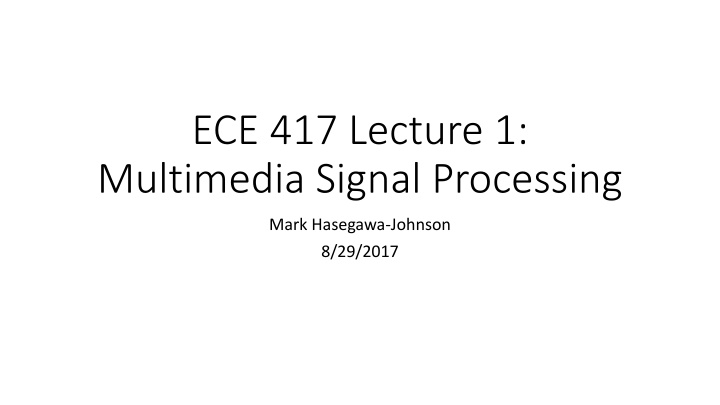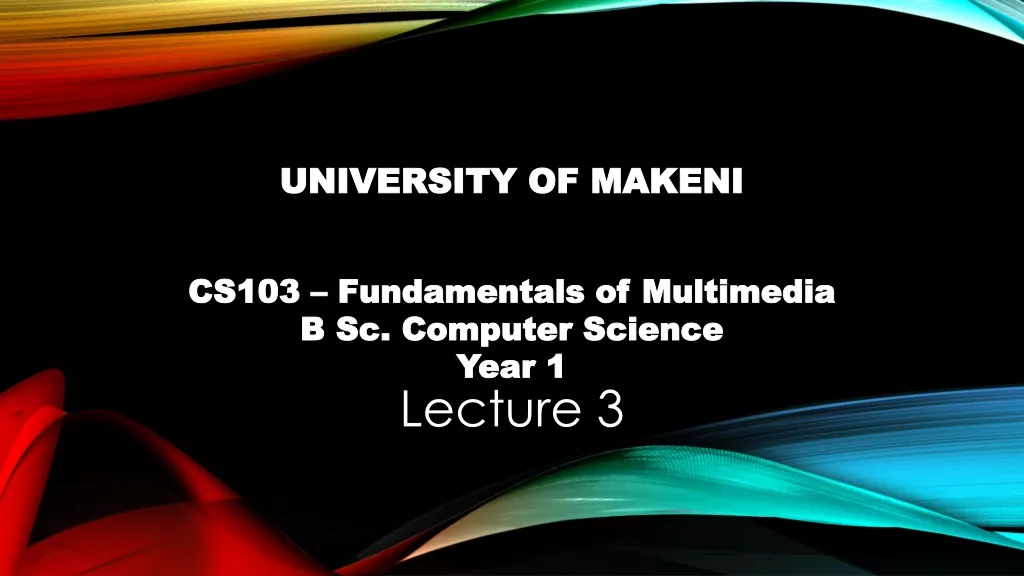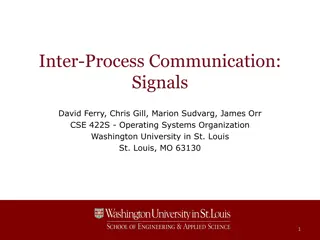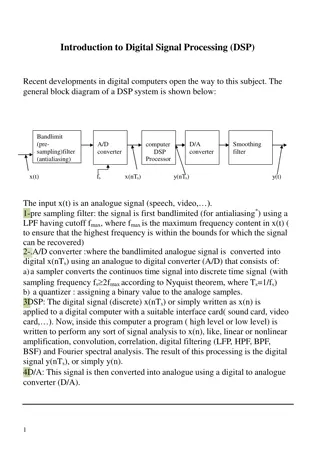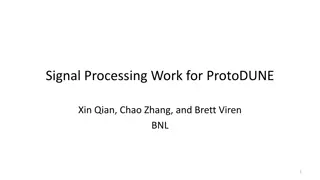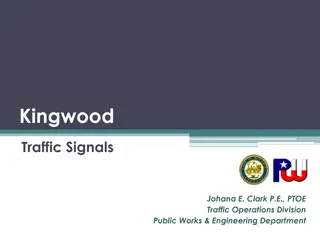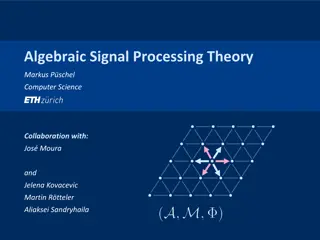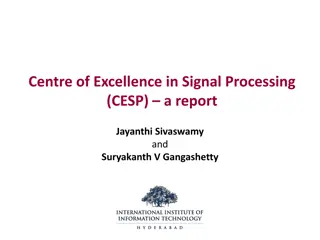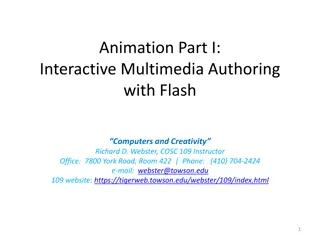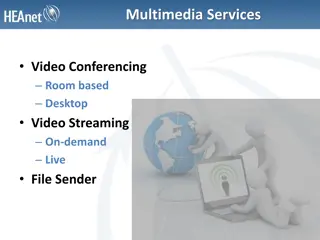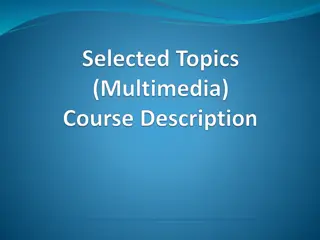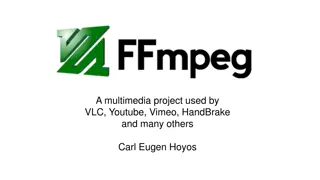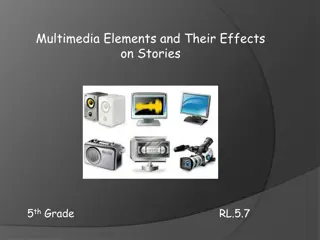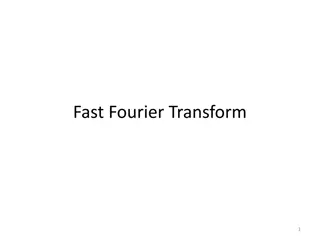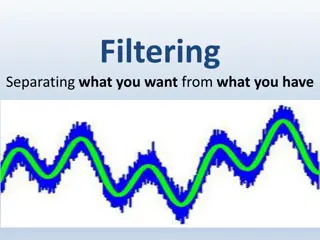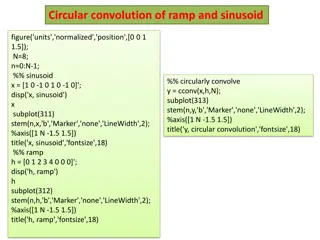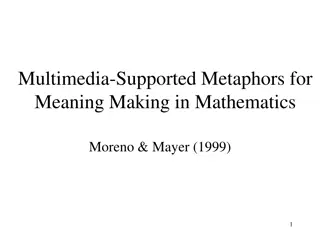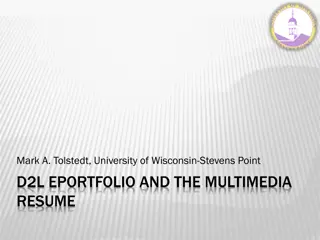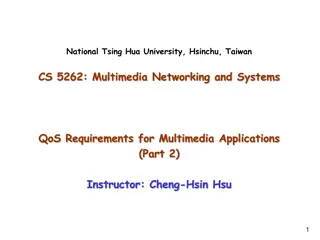Multimedia Signal Processing Overview
Today's lecture covers an overview of multimedia signal processing, including important linear algebra concepts. The syllabus outlines what will be learned this semester, such as the basic architecture of encoding, embedding, aligning, and decoding. The lecture delves into categories of parametric learning methods and types of parameters that can be learned from data. It also explores the significance of multimedia formats like audio, video, and images, discussing the challenges posed by large data sizes in training neural networks. The lecture further explains the importance of reducing parameters, especially in image and audio processing, by exploring tricks and methods to optimize learning.
Download Presentation

Please find below an Image/Link to download the presentation.
The content on the website is provided AS IS for your information and personal use only. It may not be sold, licensed, or shared on other websites without obtaining consent from the author.If you encounter any issues during the download, it is possible that the publisher has removed the file from their server.
You are allowed to download the files provided on this website for personal or commercial use, subject to the condition that they are used lawfully. All files are the property of their respective owners.
The content on the website is provided AS IS for your information and personal use only. It may not be sold, licensed, or shared on other websites without obtaining consent from the author.
E N D
Presentation Transcript
ECE 417 Lecture 1: Multimedia Signal Processing Mark Hasegawa-Johnson 8/29/2017
Todays Lecture Syllabus Overview of what we ll learn this semester Review of important linear algebra concepts, part one Sample problem
Syllabus Go read the syllabus: http://courses.engr.Illinois.edu/ece417/
Overview of what well learn this semester What is multimedia? What is processing? The basic architecture: encoder, embedder, aligner, decoder Parametric learning: categories of methods, types of parameters that you can learn from data
What is multimedia? Audio, Video, and Images Defining feature #1: very big Speech audio: 16000 samples/second Multimedia audio: 44100 samples/second (often downsampled to 22050!) Image: 6M pixels ~ 2000x3000 (often downsampled to 224x224) Video: 640x480 pixels/image, 30 frames/second = 9,216,000 real numbers per second Why very big matters: you can t train a neural net to observe a whole image Rule of 5: there must be 5 training examples per trainable parameter Two-layer neural net with 1024 hidden nodes, 6M inputs has 1024*6000000 trainable parameters = 6 billion trainable parameters With 6 billion trainable parameters, you need 30 billion training examples Result: we need some trick to reduce the number of parameters This semester is all about finding tricks that work (much better)
What is Multimedia: Defining Feature #2 Defining feature #2: variable input dimension Image classification, e.g., imagenet: we like to downsample every image to 224x224 first, then train a NN with 224*224=50176 inputs Audio speech recognition: no can do Why? Solution: streaming methods Recognition instead of Classification --- variable number of inputs, variable number of outputs
Processing = convert from one type of signal to another Image Video Audio Text (variable- length sequence of symbols) Metadata (tags drawn from predefined set) Image X Motion prediction Animation Spoken captioning Automatic captioning Object recognition Face recognition Video Heat map Frame capture Summarization Shot boundary detection X Lipreading/ Speechreading Audiovisual speech recognition Summarization Audio Spectrogram(S TFT) STFT Avatar animation X Automatic speech recognition Music genre Emotion/sentimen ts Speaker ID Text Audiovisual speech synthesis Speech synthesis X Sentiment Metadata Search Search Search X
Basic Multimedia Architecture: EEAD Decoder (compute outputs) n=Output Timescale Aligner (time alignment) Embedder (compute state) Encoder (compute features) t=Input Timescale
Parametric Learning What it means: 1. Define some general family of functions, ? = ?( ?, ?), where ? is an input feature vector, and ? is a set of learnable parameters. For example, in MP1, it will be something like ? = [?1 ?2, ] 2. Learn the parameters: choose W in order to maximize performance on some training dataset ?1,?2
Types of Parametric Learning Metric Learning/Feature Learning (MP1): Learn to convert input features into some new feature set that better matches human perception Classifier Learning (MP2, MP3): Learn to classify the input. Bayesian Learning (MP4, MP5): Learn to estimate how likely the input is, given some assumed class label. Deep learning (MP6, MP7): Combines feature learning and classifier learning. Each layer computes features that are used by the next layer up.
Basics of Linear Algebra Vector Space Banach Space, Norm Hilbert Space, Inner Product Linear Transform Affine Transform
Vector Space A vector space is a set, closed under addition, that satisfies: Addition commutativity Addition associativity Addition identity element Addition inverse Compatibility of scalar and field multiplication Multiplication identity element Distribution of multiplication over vector addition Distribution of multiplication over field addition
Banach space, Norm A Banach space is a vector space with a norm. A norm is: Non-negative Positive definite Absolute homogeneous Satisfies the triangle inequality
Inner Product Space An inner product space is a Banach space with a dot product (a.k.a. inner product). An inner product is a function of two vectors that satisfies: Conjugate commutative Linear in its first argument Positive definite
Linear Transform A linear transform converts one vector space into another, with the following rules: Homogeneous Satisfies superposition A linear transform is written as a matrix multiplication, y=Wx
Affine Transform An affine transform is a linear transform plus an offset. It s usually written as y=Wx+b, where Wx is the linear part, and b is the offset.
Example Problem Suppose that ? is a vector of 312 image features including the color from each of 26 different sub-images (78 features total), and the 3x3 Fourier transform of each of the 26 different sub-images (234 features), for a total of 312 features per image. Suppose that ? 1,1 is its class label (either +1 or -1). Suppose that ?? and ?? are training examples, for 1 ? ?. From these training data, we want to learn a parametric classifier that estimates y from x.
How many trainable parameters? Method 1: ? = ????(??? + ?) Method 2: ? ( ??? ??) ? = ???????=1 ? = ????(??) Method 3: 2 ?? ??? ??? 1 1 ?( ?=1 ? = ????(??) ? 2 ? = ???????=1 ???? )
